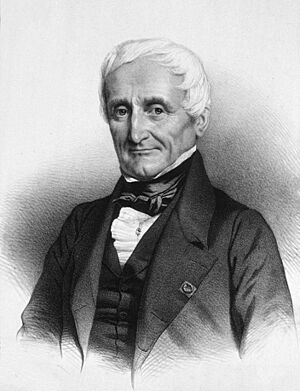André Marie Constant Duméril facts for kids
Quick facts for kids
André Marie Constant Duméril
|
|
|---|---|
 |
|
| Born | 1 January 1774 |
| Died | 14 August 1860 (aged 86) |
| Education | University of Rouen |
| Known for | Zoologie analytique |
| Children | Auguste Duméril |
| Awards | Académie des Sciences, American Philosophical Society, commander of the Légion d'Honneur |
| Scientific career | |
| Fields | Zoology |
| Institutions | Muséum national d'histoire naturelle |
| Author abbrev. (zoology) | Duméril |
André Marie Constant Duméril (born January 1, 1774 – died August 14, 1860) was an important French zoologist. A zoologist is a scientist who studies animals. He taught anatomy (the study of body structures) at a big museum in France. This was the Muséum national d'histoire naturelle. Later, he became a professor of herpetology (the study of reptiles and amphibians) and ichthyology (the study of fish). His son, Auguste Duméril, also became a zoologist. When you see "Duméril" as the person who named an animal, it could be either André or his son!
Contents
A Life of Science
André Marie Constant Duméril was born in Amiens, France. He was born on January 1, 1774. He passed away in Paris on August 14, 1860.
He became a doctor at a very young age. When he was just 19, he became a leader in anatomy at the medical school in Rouen. In 1800, he moved to Paris. There, he helped a famous scientist named Georges Cuvier with his lessons. These lessons were about comparative anatomy. This is the study of how different animals' bodies are similar and different.
Teaching and Research
Duméril took over Cuvier's teaching spot at the Central School of the Panthéon. He worked with another scientist, Alexandre Brongniart. In 1801, he started teaching at the Paris medical school.
Later, he was chosen to be a member of the Académie des Sciences. This is a very important French science academy. After 1803, he took over from Bernard Germain de Lacépède. Lacépède was busy with his political jobs. Duméril became a professor of herpetology and ichthyology. He taught at the Muséum national d'histoire naturelle. He officially got this professor job in 1825, after Lacépède passed away.
Important Books and Discoveries
In 1806, Duméril published his book called Zoologie analytique. This book covered all kinds of animals. It showed how different groups of animals were related. In 1813, he became a member of the American Philosophical Society in Philadelphia.
In 1832, a helper named Gabriel Bibron started working with him. Bibron helped describe new animal species for a bigger version of Zoologie analytique. Another scientist, Nicolaus Michael Oppel, helped with a new way to classify animals. After Bibron passed away, Duméril's son, Auguste Duméril, took his place. Bibron's death made the new book take 10 more years to publish.
In 1851, André and Auguste Duméril published a book about reptiles. It was called Catalogue méthodique de la collection des reptiles. In 1853, André Duméril alone published a book about snakes. It was called Prodrome de la classification des reptiles ophidiens. This book suggested a way to classify all snakes.
Duméril also found some old preserved fish. They were in the attic of the house of Georges-Louis Leclerc, Comte de Buffon. These fish had been collected almost 70 years earlier by Philibert Commerson. Duméril finally described these species.
Studying Reptiles and Insects
He then published a very important work. It was called l’Erpétologie générale ou Histoire naturelle complète des reptiles. This huge work had nine volumes and was published between 1834 and 1854. In it, he described 1,393 species of reptiles in great detail. He wrote about their bodies, how they worked, and where to find more information about them. However, Duméril still grouped amphibians with reptiles. This was even though other scientists had shown they were different.
Duméril was interested in insects his whole life. He wrote several papers about them. His main book on insects was Entomologie analytique, published in 1860. With his son Auguste, he created the first vivarium for reptiles. A vivarium is like a special habitat where animals can live and be observed. This one was at the Jardin des Plantes in Paris. Duméril always thought that watching how animals behaved was important for classifying them.
After 1853, he started letting his son take over his work. He fully retired in 1857. He was given a high honor, the commander of the Legion of Honour, two months before he passed away.
Species Named After A.M.C. Duméril
Many animals have been named after André Marie Constant Duméril to honor his work. Here are some of them:
- The worm Platynereis dumerilii
- The Greater Amberjack fish Seriola dumerili
- The bryozoan Callopora dumerilii
- The moth Luperina dumerilii
- The isopod Rocinela dumerilii
- The aquatic isopod crustacean Sphaeroma dumerilii
- The Filefish Cantherhines dumerilii
- The Lizard Acanthodactylus dumerilii
- The Boa Snake Acrantophis dumerili
- The wolf snake Lycodon dumerili
- The coral snake Micrurus dumerilii
- The Amazon River Turtle Peltocephalus dumerilianus
- The lizard Stenocercus dumerilii
- The Snake Urotheca dumerilii
- The Monitor Lizard Varanus dumerilii
See Also
 In Spanish: André Marie Constant Duméril para niños
In Spanish: André Marie Constant Duméril para niños
- Gabriel Bibron
- Auguste Duméril

